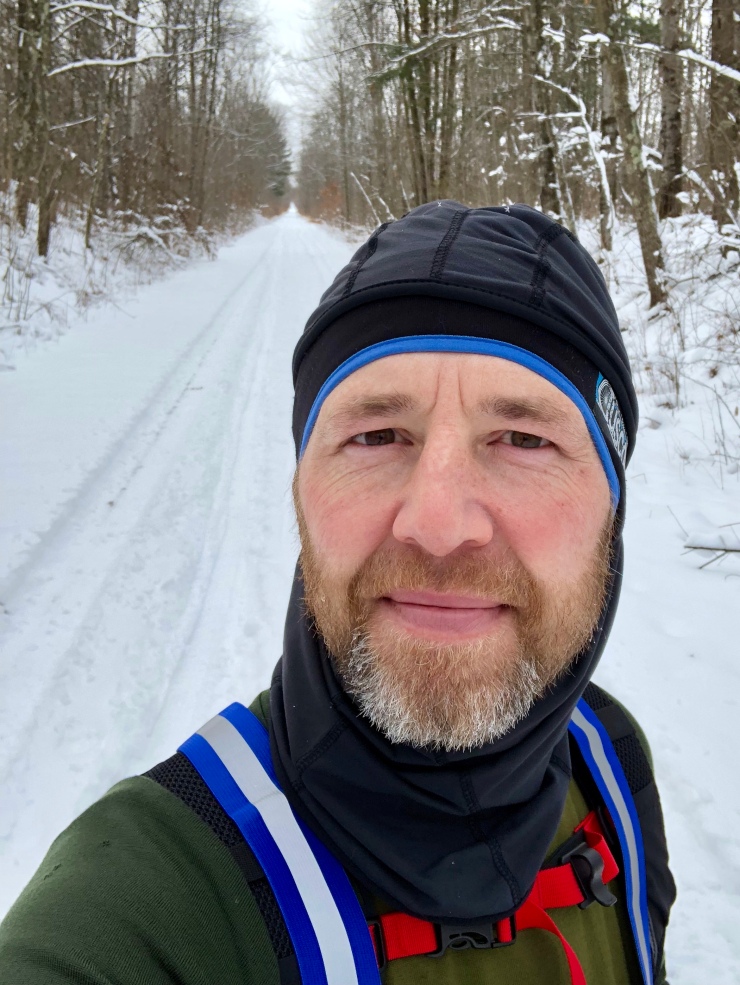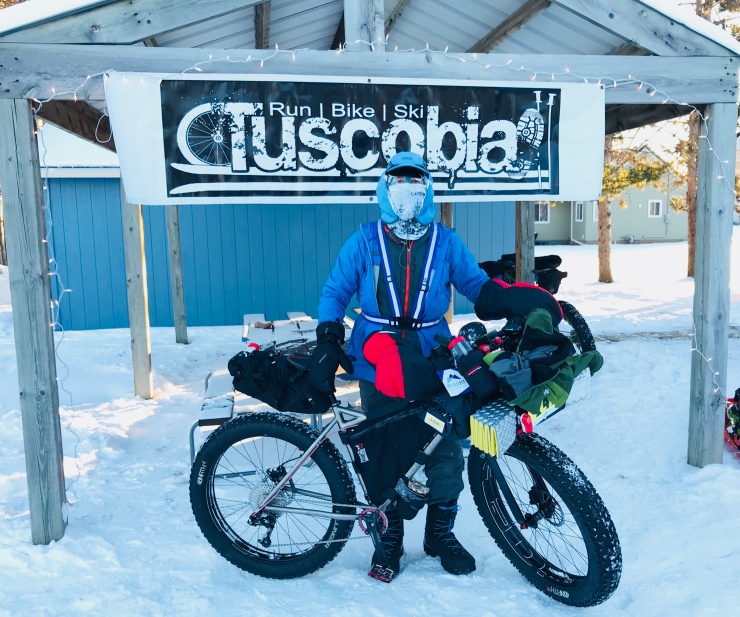Here at St Croix 40 Winter Ultra, we want to help you be successful in your entry to winter ultra racing. As a part of this, we want to share with you tips and tricks from people who have been there, in the big races, and have sometimes learned the hard way what works and what doesn’t.
Our next entry focuses on biking in these winter ultra events. James Kiffmeyer is an experienced winter ultra athlete, and in this interview he shares how to be prepared for tackling the cold on two wheels instead of two feet.
Thank you James for taking the time to talk with us!
Thanks much for the opportunity to talk about winter ultra fat biking! I think St Croix 40 will be a great addition, and a much needed opportunity for people interested in getting into winter ultra fat biking. The change from regular winter fat biking to ultra winter fat biking is much bigger than the changes moving to summer ultra biking, involving a whole hosts of gear and issues that take a while to get sorted out. I highly recommend the St Croix 40 to anyone interested in winter ultras!
Please briefly list your winter ultra resume
My experience includes Tuscobia 80, Tuscobia 160, AH135, and Actif Epica 200.
What’s your favorite piece of gear that might not be on the gear list? (What non-mandatory piece of gear would you not leave home without?)
My trusty headband from RM GEAR (given out at Tuscobia) (Ed: St Croix 40 sponsor as well!) is my favorite piece of gear. It covers my ears without being bulky, it’s the perfect base layer for your head. I add layers as needed, but never go without it. (I got pretty bad frostbite my first year doing Tuscobia when an ear lobe slipped out from under my hat.)

How many layers do you bring along for a winter ultra? How do you manage multiple layers and sweating for different situations?
Layering depends on the temp and wind, but the best plan is to have each specific layer fitting a specific purpose. There is the base layer, I wear a favorite soft thin synthetic t-shirt. Just something I like to keep moisture moving away from the skin around my core. Above that I wear a fairly thin wool long sleeve shirt which provides the bare minimum for winter biking. If temps are above 20-30 that is all I have on. Next I have either a synthetic highly breathable insulated jacket or a wind shirt/jacket. Both keep in a bit more warmth without sacrificing ventilation, which one I use first depends on the conditions and what I need, insulation or wind break, but if I need both the wind jacket goes on top. I keep a thin puffy down jacket at the ready, mostly for when stopped for a while along the trail. Finally, I usually carry a rain jacket that would be my final layer if absolutely needed. Due to lack of ventilation I wouldn’t really want to use that jacket, but if needed for warmth due to extreme cold (or rain when warmer) I would want it with me. All these layers are thin and light, nothing is thick or multipurpose.
For my bottom half I start with bike bibs, followed by wool tights. Above that is a light weight nylon pants, the sort used for rock climbing or adventure wear. I bring rain pant in case needed for warmth or moisture protection, but but never worn them. A light insulated pant would serve the same purpose. Socks are a light wool layer followed by a an expedition weight wool sock.
Notice the only bike specific piece of gear here is the bibs, I think that is the single biggest mistake new winter ultra bikers make. Trying to make biking specific gear work for ultras. I’m not saying it can’t work or won’t work, just that it isn’t a given that you need bike specific gear, and often biking specific gear is just wrong for this sport. Ventilation is too important, moisture is the number one issue in temperature management. Tight jackets that keep too much moisture in create problems, same with pants. But some do use them with success.
Do you have a favorite brand for certain gear pieces? What do you swear by?
- Icebreaker wool shirt (I have various thicknesses and styles, favorite is BodyfitZONE Winter Zone Long Sleeve Half Zip)
- Patagonia nano air jacket (perfect weight, wonderful ventilation, highly recommend)
- Windveil jacket by Rab (super light wind jacket, great top layer)
- Wolfgar by 45NRT (Great boot if you clip in, but clipless is not really a big deal. Key for any boot is to go a few sizes larger so you have room for circulation, swelling, toe warmers)
- 45NRTH Greazy cap. (Covers ears well, too heavy though unless well below zero)
- OR Water Bottle Parkas over Thermos 24oz double wall drink bottles (throw 3 of these on your bike and you are set for any race at any temperature.)

What’s your foot care regimen for preventing blisters, trench foot, frostbite?
Foot care is so very specific to the person, it’s really hard to make recommendations. What works for me is just wool socks and large boots, allowing plenty of room for circulation and toe warmers as needed. My feet never sweat, but if yours do then definitely adjust your foot care to cover that, with liners that can be as simple as bread bags. If you get a hot spot or cold toes, it’s extremely important to treat that right away. Get off your bike and walk, add a toe warmer, find out if there is a wrinkle in your socks, get air to your chemical warmers if they stop working (or replace them), put on dry socks, etc. DO NOT assume you can just keep going and figure it out later, that is how you DNF. That goes for your whole body as well, if you get cold or start to sweat stop immediately and adjust your layers, don’t wait to take action.
People might look at biking in these events as the “easy” mode. What are some of the unique challenges to people on two wheels that others on feet might not understand?
Packing, complexity, and energy output are key differences between running and biking.
First, you can’t just put things loosely in a sled, you need to carefully pack things on a bike. That means organization, because you need both secure storage and easy access. If something falls, it can get caught in various bike parts and end your ride pretty quickly. The first ultra I did my earbuds dropped in my chain and wrapped around my cassette. I spent valuable time ripping them out of the cassette, with my fingers freezing, hoping the bike would still shift through the gears when I was done since I couldn’t get them completely out. If you need your sleeping bag and it is too securely packed on your bike, you might get into trouble. Think of frozen fingers fumbling with buckles on a tightly packed front roll, pulling compressed sleeping bag out of a tightly packed dry bag, all while exhausted and freezing. If you don’t pack right you can jeopardize your life.
Complexity plays a big part, bikes can struggle with the cold over time. Last year I had my rear hub start skipping around 125 miles into Tuscobia at 2am in the middle of nowhere, every so often my cranks would just spin with no effect. Now I run tip-up grease in the rear hub to keep it working at those temps. At AH135 the rear derailleur stop pin bent out of place and I couldn’t use much of my gears during the hills. I would have to pick the bike up and spin the crank to change gears at the top of each hill to get to the smaller rings in back. At the start of Tuscobia last year I got a flat tire and had to insert a tube, resulting in frost bite through my liner gloves as I was handling the aluminum rims. Having a complex machine to take care of is just different, it might pose no problems, or it could stop you in an instant.
Which brings me to the third point, you can go from big energy output, to none, very quickly. If you are sweating and suddenly your bike breaks down, how long are you going to stay warm as the wind whips by you. If your fingers get cold, it’s hard to tuck them in your crotch, you have to hold the handlebar. If your toes get cold, the circulations to them stops because your feet aren’t flexing with each step. So on the one hand you need to manage the bigger heat output you can generate while biking (big potential for sweating), while on the other dealing with the inability to keep hands and feet warm.
 Obviously that doesn’t make biking “harder” than running these ultra events. The time frames involved are shorter for bikers, both for the race and for the times between check points. Runners have bigger issues with feet being on the ground, making it hard to keep feet dry. Runners have bigger issues with weight, for bikers the weight is on wheels so it moves easier than on a sled. All in all, it’s just different, and it’s good to appreciate those differences.
Obviously that doesn’t make biking “harder” than running these ultra events. The time frames involved are shorter for bikers, both for the race and for the times between check points. Runners have bigger issues with feet being on the ground, making it hard to keep feet dry. Runners have bigger issues with weight, for bikers the weight is on wheels so it moves easier than on a sled. All in all, it’s just different, and it’s good to appreciate those differences.
All in all, winter ultra fat biking is a unique and challenging sport. The answers I give are not true for everyone, it varies very widely what works or doesn’t work for individuals. Don’t go out and try to outfit yourself quickly, and don’t go out and copy anyone’s setup. Start biking and find what works for you. Try various things at various temperatures and conditions, for enough time to really know how it works for you. The most important determination of finishing a race is NOT your physical conditioning and ability to pedal those ultra distance miles. It’s the ability to manage your heat/sweat output, manage your hand and foot warmth, manage your hydration (and food intake), and manage your mental fortitude. Physical strength lets you focus on these other areas better, but you can’t finish the race on physical strength alone.
And finally, the winter ultra family is by far the most wonderful aspect of this sport! Be sure not to skimp on the friendships and camaraderie you are able to experience through the sharing of both misery and joy at these events.

Just realized I forgot to include ColdAvenger to the gear list, that helped a ton last year.
LikeLiked by 1 person
In my opinion, this is one of the best interview articles written on the whole winter ultra challenge idea whether one tackles it on foot, by bike or on skis and it comes from a very accomplished yet humble athlete with a most impressive resume. James is right in that we are all individuals and need to approach things from our own perspective and what works for one may not work for another and he is definitely correct in that the winter ultra “family” is awesome, inclusive and supportive! Good luck this season James! PS: Hope you liked the perogies at Actif Epica – I think you’ll agree they make excellent take along snacks.
LikeLiked by 1 person